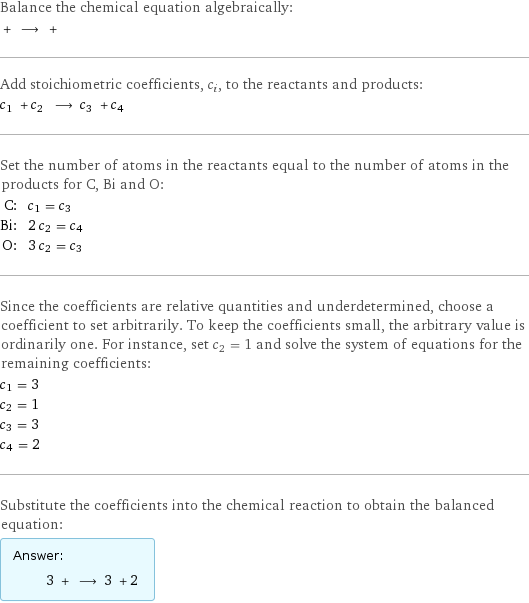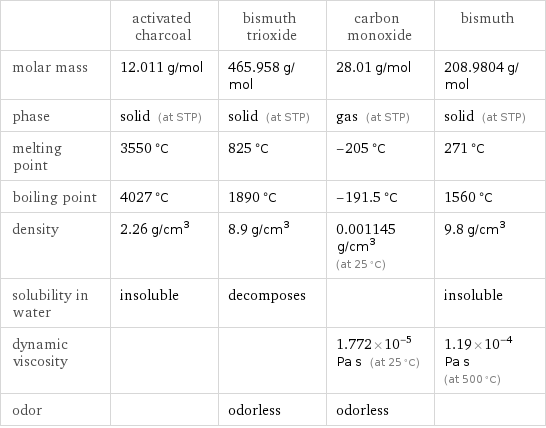Input interpretation

activated charcoal + bismuth trioxide ⟶ carbon monoxide + bismuth
Balanced equation

Balance the chemical equation algebraically: + ⟶ + Add stoichiometric coefficients, c_i, to the reactants and products: c_1 + c_2 ⟶ c_3 + c_4 Set the number of atoms in the reactants equal to the number of atoms in the products for C, Bi and O: C: | c_1 = c_3 Bi: | 2 c_2 = c_4 O: | 3 c_2 = c_3 Since the coefficients are relative quantities and underdetermined, choose a coefficient to set arbitrarily. To keep the coefficients small, the arbitrary value is ordinarily one. For instance, set c_2 = 1 and solve the system of equations for the remaining coefficients: c_1 = 3 c_2 = 1 c_3 = 3 c_4 = 2 Substitute the coefficients into the chemical reaction to obtain the balanced equation: Answer: | | 3 + ⟶ 3 + 2
Structures

+ ⟶ +
Names

activated charcoal + bismuth trioxide ⟶ carbon monoxide + bismuth
Equilibrium constant
![K_c = ([CO]^3 [Bi]^2)/([C]^3 [Bi2O3])](../image_source/c90665b2df5508ec774e5879e01d3565.png)
K_c = ([CO]^3 [Bi]^2)/([C]^3 [Bi2O3])
Rate of reaction
![rate = -1/3 (Δ[C])/(Δt) = -(Δ[Bi2O3])/(Δt) = 1/3 (Δ[CO])/(Δt) = 1/2 (Δ[Bi])/(Δt) (assuming constant volume and no accumulation of intermediates or side products)](../image_source/40a1423cdb214a8920788c089751143e.png)
rate = -1/3 (Δ[C])/(Δt) = -(Δ[Bi2O3])/(Δt) = 1/3 (Δ[CO])/(Δt) = 1/2 (Δ[Bi])/(Δt) (assuming constant volume and no accumulation of intermediates or side products)
Chemical names and formulas

| activated charcoal | bismuth trioxide | carbon monoxide | bismuth Hill formula | C | Bi_2O_3 | CO | Bi name | activated charcoal | bismuth trioxide | carbon monoxide | bismuth IUPAC name | carbon | oxo-oxobismuthanyloxybismuthane | carbon monoxide | bismuth
Substance properties

| activated charcoal | bismuth trioxide | carbon monoxide | bismuth molar mass | 12.011 g/mol | 465.958 g/mol | 28.01 g/mol | 208.9804 g/mol phase | solid (at STP) | solid (at STP) | gas (at STP) | solid (at STP) melting point | 3550 °C | 825 °C | -205 °C | 271 °C boiling point | 4027 °C | 1890 °C | -191.5 °C | 1560 °C density | 2.26 g/cm^3 | 8.9 g/cm^3 | 0.001145 g/cm^3 (at 25 °C) | 9.8 g/cm^3 solubility in water | insoluble | decomposes | | insoluble dynamic viscosity | | | 1.772×10^-5 Pa s (at 25 °C) | 1.19×10^-4 Pa s (at 500 °C) odor | | odorless | odorless |
Units
